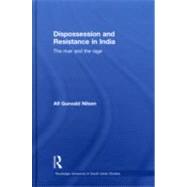
Note: Supplemental materials are not guaranteed with Rental or Used book purchases.
Purchase Benefits
Looking to rent a book? Rent Dispossession and Resistance in India: The River and the Rage [ISBN: 9780415558648] for the semester, quarter, and short term or search our site for other textbooks by Nilsen; Alf Gunvald. Renting a textbook can save you up to 90% from the cost of buying.
| Acknowledgements | p. xi |
| The river and the rage: Introducing the Narmada Valley conflict | p. 1 |
| Dispossession and resistance in the Narmada Valley | p. 5 |
| Understanding movement processes | p. 13 |
| Losing ground: Accumulation by dispossession in the Narmada Valley | p. 18 |
| Accumulation by dispossession in the Narmada Valley | p. 20 |
| Accumulation by dispossession and the political economy of postcolonial capitalism in India | p. 38 |
| Concluding remarks | p. 45 |
| Everyday tyranny and rightful resistance: The emergence of the Khedut Mazdoor Chetna Sangath | p. 47 |
| The contours of everyday tyranny | p. 49 |
| The emergence of the KMCS | p. 58 |
| Rightful resistance and catalytic work in subaltern politics | p. 63 |
| Concluding remarks | p. 68 |
| Discovering the dam: Militant particularist struggles for resettlement and rehabilitation | p. 70 |
| The Narmada Dharangrasta Samiti | p. 71 |
| The ARCH Vahini | p. 82 |
| The Narmada Ghati Navnirman Samiti | p. 85 |
| Concluding remarks | p. 90 |
| Towards opposition: The formation of the anti-dam campaign | p. 93 |
| The radicalization and abstraction of resistance | p. 94 |
| Divergence and convergence in the formation of the anti-dam campaign | p. 108 |
| Concluding remarks | p. 116 |
| Cycles of struggle: The trajectory of the anti-dam campaign, 1990-2000 | p. 118 |
| Jury politics and direct action | p. 119 |
| 'Hamare Gaon, Mein Hamare Raj' | p. 125 |
| The international Narmada campaign and the independent review | p. 131 |
| Jury politics revived and revisited | p. 135 |
| The limits of jury politics and the political economy of the state | p. 142 |
| Concluding remarks | p. 146 |
| Enablements and constraints: The making of the Maheshwar anti-dam campaign | p. 149 |
| Factors of enablement in the Maheshwar campaign | p. 150 |
| The role of women in the Maheshwar campaign | p. 154 |
| Factors of constraint in the Maheshwar campaign | p. 158 |
| Concluding remarks | p. 168 |
| Development, not destruction: Alternative development as a social movement project | p. 170 |
| Challenging the postcolonial development project | p. 171 |
| Building a capacity for hegemony | p. 187 |
| Concluding remarks | p. 192 |
| Whither the rage? Learning from the Narmada Valley movement process | p. 194 |
| Summary of the argument | p. 194 |
| Whither the rage? | p. 199 |
| Notes | p. 203 |
| Bibliography | p. 211 |
| Index | p. 226 |
| Table of Contents provided by Ingram. All Rights Reserved. |
The New copy of this book will include any supplemental materials advertised. Please check the title of the book to determine if it should include any access cards, study guides, lab manuals, CDs, etc.
The Used, Rental and eBook copies of this book are not guaranteed to include any supplemental materials. Typically, only the book itself is included. This is true even if the title states it includes any access cards, study guides, lab manuals, CDs, etc.